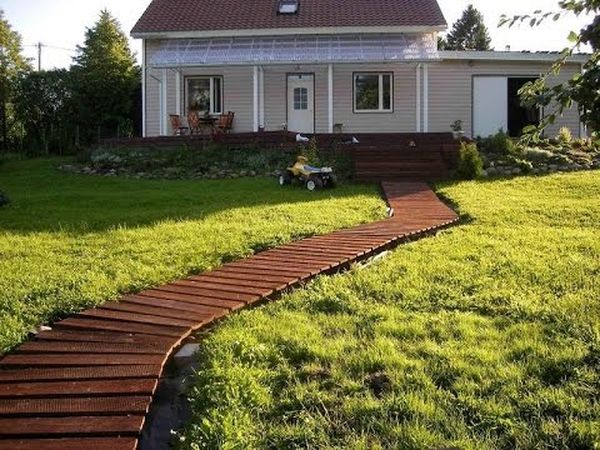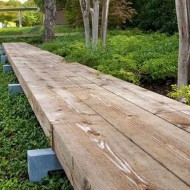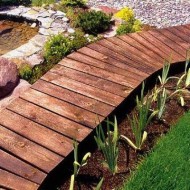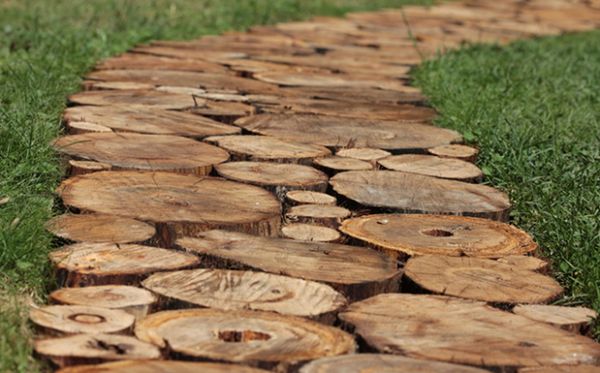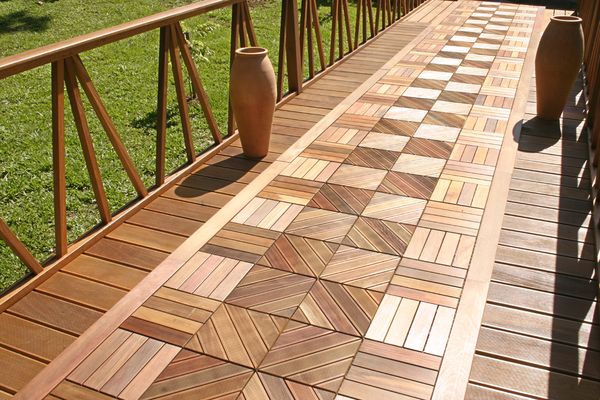Budget luxury: garden paths made of wood according to design samples
Content
Advantages and disadvantages
Not every material can compete with wood in its ability to create comfort and natural beauty. Wooden paths will look beneficial and harmonious in almost any style of landscape design. However, the tree has both advantages and disadvantages that must be considered when laying and operating paths. The unconditional merits include:
- material safety: a natural product is environmentally friendly, therefore safe for human health;
- versatility: the variety of wooden materials makes it possible to build an individual structure that fits perfectly into the general character of the area;
- ease of installation: laying paths does not require long time and special skills, if you wish, you can do it yourself;
- ease of care;
- Availability: for the price, wood is inexpensive compared to other natural materials, you can also use not only solid parts, but also waste.
It will be fair to note the shortcomings of the material, which must be taken into account not only during installation, but also during operation:
- rather short service life: wood is faster than other materials to be destroyed under the influence of natural factors, but today this problem can be solved with the help of special processing tools;
- flammability: natural material is not only environmentally friendly, but also easily flammable;
- partial insecurity: after getting wet, the tree becomes slippery, which makes it difficult to walk on it and increases the risk of injury.
Video "Handmade path from oak stumps"
From this video you will learn how to make a solid path from oak hemp with your own hands.
Track options
Based on the options for laying paths in summer cottages and household plots, you can choose the following types of paths: dug in or laid. The choice often depends not only on desire, but also on the characteristics of the area. Paved walkways are perfect for cottages by the sea or for areas near rivers with shallow groundwater.
When laying, the main canvas is laid on a frame, which is laid at a certain distance from the ground on a special pre-prepared base. Raising the frame provides air access and ventilation, which helps to protect the track from waterlogging and extend its service life. It is recommended to lay such structures with small slopes so that precipitation does not linger.
As a frame, longitudinal logs are used, on which boards or beams are attached. The optimal width for this type of structure will be a path of at least 80 cm. The thickness of the board is from 25 mm. For dug-in structures, wood elements are placed in the ground exactly at ground level or protruding slightly above it. The resulting void is filled with drainage.Crushed stone, coarse sand, granite screenings are perfect. For this version of the tracks, you need to choose strong varieties of wood and be sure to carefully process the material with moisture-protective agents. In addition to drainage, the soil is well compacted under the structure, and the bottom is covered with geotextiles.
Laying technology
Each type of wood material has its own characteristics during the installation process. The choice of the base for the track depends on the planned material costs. The cuts will cost little, the boards can be either from economy class varieties or from expensive types of wood.
From planks
Laying an edged board track is pretty straightforward. Therefore, if you have all the necessary tools for woodwork and a detailed diagram, you can master the process yourself. Both the quality and the degree of decorativeness of the track depend on the choice of material. Usually larch or pine is chosen for such paths. You can make the path as a flooring (at a height of 10 cm) or dig it into the ground. Board thickness - from 40 mm. Before laying, the boards are treated with an antiseptic, painted or covered with wood stain, varnish. It is also necessary to take into account the fact that over time the boards will swell and expand, so you need to leave a small gap.
The installation of the path consists of the following steps:
- Arrangement of the base for water drainage. To do this, you need to dig a trench, tamp the bottom and cover it with geotextiles. Then add a layer of drainage.
- Installation of the frame. The base is mounted on logs, which need to be processed and additionally wrapped with roofing material.
- Installation of crossbars on logs no more than every meter.
- Fastening the flooring. The boards are screwed to the frame with screws or fastened with nails.
The dug-in paths are laid directly on the drainage layer and, for decorative purposes, can be covered with fine pebbles or sand.
From cuts
Laying log cabins is a longer process, which consists of the following stages:
- Training. First you need to mark the path in real dimensions. Remove the fertile soil layer, dig a trench.
- Level the bottom of the ditch and lay geotextiles so that the drainage base does not mix with the soil.
- Fill alternately a layer of rubble and sand, tamp them. It is recommended to lay another layer of geotextile between them.
- The cuts are set in level, a little deepening into the sand with a rubber hammer.
- The gaps between the log cabins can be filled at will with various materials - sand, pebbles, gravel.
From cuts of different shades or sizes, you can lay out a pattern.
Decking
Decking is a synthetic material made of plastic and shredded wood. It is resistant to weather changes and does not require additional processing. However, only a flat surface is suitable for laying it. Decking is laid according to the example of a laminate:
- Pouring the base. A cement screed is ideal.
- Installation of flooring on logs made of a similar material in increments of 20 or 30 cm. To prevent moisture stagnation, you need to leave a gap of several millimeters. Installation is carried out by fastening the elements to the base with self-tapping screws. It is also possible to mount the elements using built-in special locks on the lattice.
- Cover fasteners with plugs or paint.
Wood processing and care
Before laying, wooden parts must be treated with an antiseptic and covered with a protective material.
For coating, paint, stain or varnish can be used. The logs are covered with bituminous mastic.
From time to time, the coating needs to be renewed and the wood cleaned.

